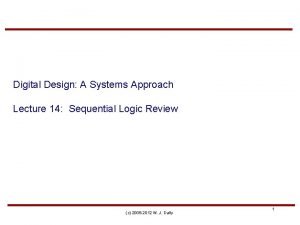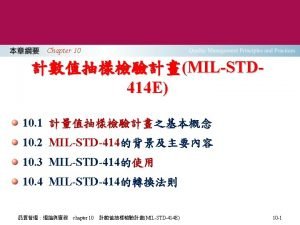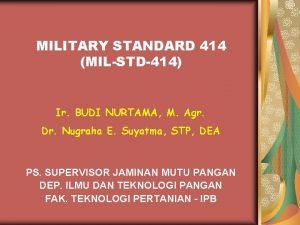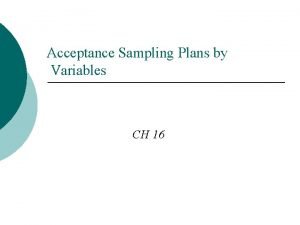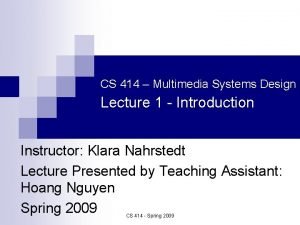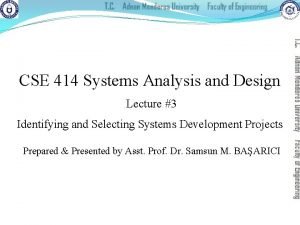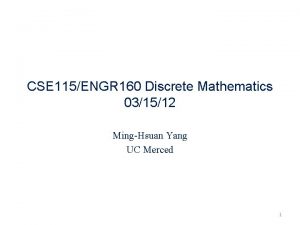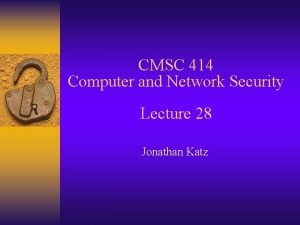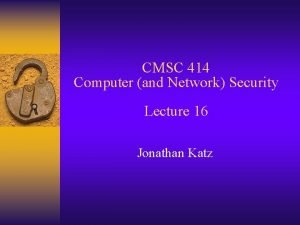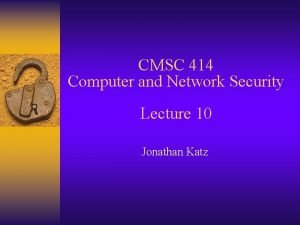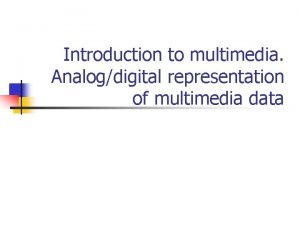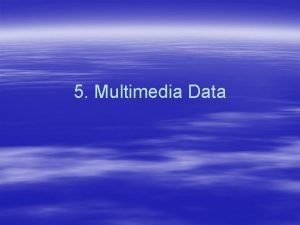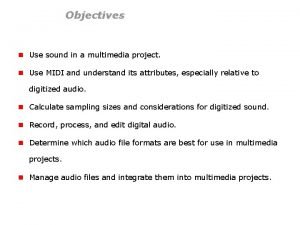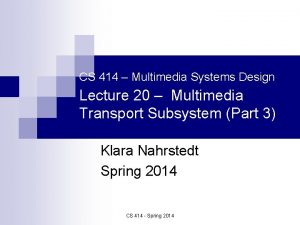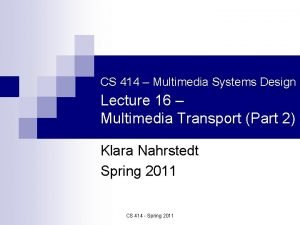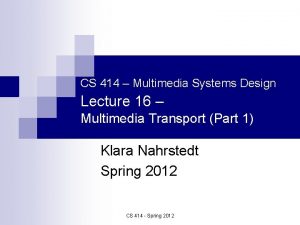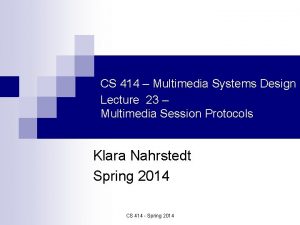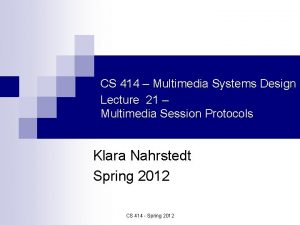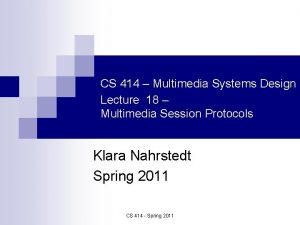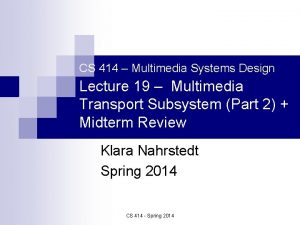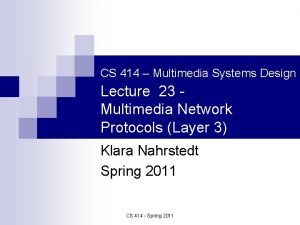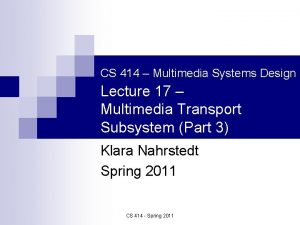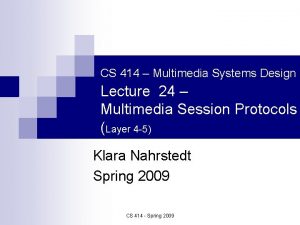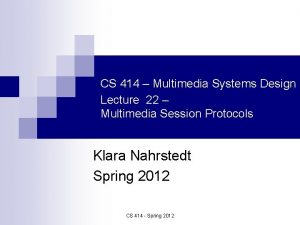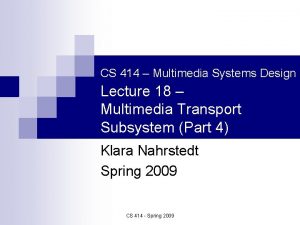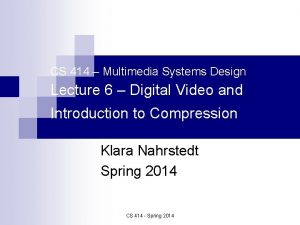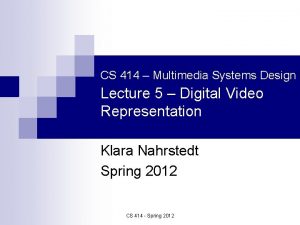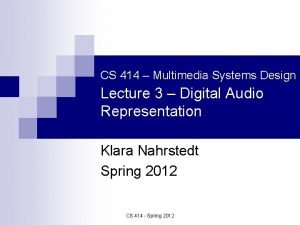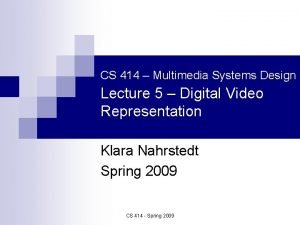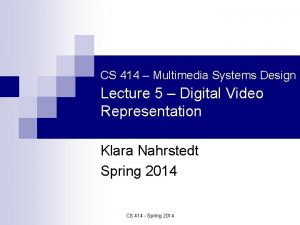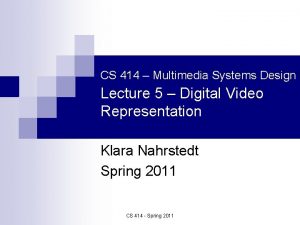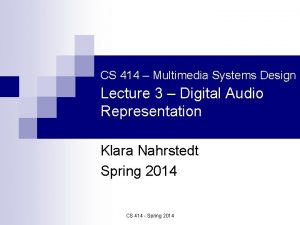CS 414 Multimedia Systems Design Lecture 4 Digital





























- Slides: 29

CS 414 – Multimedia Systems Design Lecture 4 – Digital Image Representation Klara Nahrstedt Spring 2009 CS 414 - Spring 2009

Administrative Group Directories will be established hopefully today (or latest by Friday) n MP 1 will be out on 1/28 (today) n Start by reading the MP 1 and organizing yourself as a group this week, start to read documentation, search for audio and video files. n CS 414 - Spring 2009

Images – Capturing and Processing CS 414 - Spring 2009

Capturing Real-World Images n Picture – two dimensional image captured from a real-world scene that represents a momentary event from the 3 D spatial W 2 world W 1 r W 3 F r= function of (W 1/W 3); s=function of (W 2/W 3) s CS 414 - Spring 2009

Image Concepts An image is a function of intensity values over a 2 D plane I(r, s) n Sample function at discrete intervals to represent an image in digital form n ¨ matrix of intensity values for each color plane ¨ intensity typically represented with 8 bits n Sample points are called pixels CS 414 - Spring 2009

Digital Images Samples = pixels n Quantization = number of bits per pixel n Example: if we would sample and quantize standard TV picture (525 lines) by using VGA (Video Graphics Array), video controller creates matrix 640 x 480 pixels, and each pixel is represented by 8 bit integer (256 discrete gray levels) n CS 414 - Spring 2009

Image Representations n Black and white image ¨ single 2 bits n Grey scale image ¨ single 8 bits n color plane with Color image ¨ three color planes each with 8 bits ¨ RGB, CMY, YIQ, etc. n Indexed color image ¨ single plane that indexes a color table n Compressed images ¨ TIFF, JPEG, BMP, etc. 4 gray levels 2 gray levels

Digital Image Representation (3 Bit Quantization) CS 414 - Spring 2009

Color Quantization Example of 24 bit RGB Image 24 -bit Color Monitor CS 414 - Spring 2009

Image Representation Example 24 bit RGB Representation (uncompressed) 128 135 166 138 190 132 129 255 105 189 167 190 229 213 134 111 138 187 135 255 213 190 167 138 129 229 138 189 111 Color Planes 166 105 134 132 190 187

Graphical Representation CS 414 - Spring 2009

Image Properties (Color) CS 414 - Spring 2009

Color Histogram CS 414 - Spring 2009

Image Properties (Texture) Texture – small surface structure, either natural or artificial, regular or irregular n Texture Examples: wood barks, knitting patterns n Statistical texture analysis describes texture as a whole based on specific attributes: regularity, coarseness, orientation, contrast, … n CS 414 - Spring 2009

Texture Examples CS 414 - Spring 2009

Spatial and Frequency Domains n Spatial domain ¨ refers to planar region of intensity values at time t n Frequency domain ¨ think of each color plane as a sinusoidal function of changing intensity values ¨ refers to organizing pixels according to their changing intensity (frequency) CS 414 - Spring 2009

Image Processing Function: 1. Filtering n n Filter an image by replacing each pixel in the source with a weighted sum of its neighbors Define the filter using a convolution mask, also referred to as a kernel ¨ non-zero values in small neighborhood, typically centered around a central pixel ¨ generally have odd number of rows/columns CS 414 - Spring 2009

Convolution Filter 100 100 50 50 100 100 100 0 1 0 X 0 0 0 = 0 0 0 100 100 100 CS 414 - Spring 2009 100 100 50 50 100 100 100 100

Mean Filter 20 12 14 45 15 19 55 34 81 8 64 49 23 33 22 95 Subset of image Convolution filter CS 414 - Spring 2009

Mean Filter 20 12 14 45 15 19 55 34 81 8 64 49 23 33 22 95 Subset of image Convolution filter CS 414 - Spring 2009

Common 3 x 3 Filters n Low/High pass filter n Blur operator n H/V Edge detector

Example CS 414 - Spring 2009

Image Function: 2. Edge Detection n Identify areas of strong intensity contrast ¨ filter useless data; preserve important properties n Fundamental technique ¨ e. g. , use gestures as input ¨ identify shapes, match to templates, invoke commands

Edge Detection CS 414 - Spring 2009

Simple Edge Detection n Example: Let assume single line of pixels 5 n 7 6 4 152 148 149 Calculate 1 st derivative (gradient) of the intensity of the original data ¨ Using gradient, we can find peak pixels in image ¨ I(x) represents intensity of pixel x and ¨ I’(x) represents gradient (in 1 D), ¨ Then the gradient can be calculated by convolving the original data with a mask (-1/2 0 +1/2) ¨ I’(x) = -1/2 *I(x-1) + 0*I(x) + ½*I(x+1) CS 414 - Spring 2008

Basic Method of Edge Detection Step 1: filter noise using mean filter n Step 2: compute spatial gradient n Step 3: mark points > threshold as edges n CS 414 - Spring 2009

Mark Edge Points n Given gradient at each pixel and threshold ¨ mark pixels where gradient > threshold as edges CS 414 - Spring 2009

Compute Edge Direction n n n Calculation of Rate of Change in Intensity Gradient Use 2 nd derivative Example: (5 7 6 4 152 148 149) Use convolution mask (+1 -2 +1) I’’(x) = 1*I(x-1) -2*I(x) + 1*I(x+1) Peak detection in 2 nd derivate is a method for line detection. CS 414 - Spring 2009

Summary n Other Important Image Processing Functions ¨ Image segmentation ¨ Image recognition n n n ¨ Formatting Conditioning Marking Grouping Extraction Matching Image synthesis CS 414 - Spring 2009
 01:640:244 lecture notes - lecture 15: plat, idah, farad
01:640:244 lecture notes - lecture 15: plat, idah, farad Digital systems testing and testable design
Digital systems testing and testable design Digital design a systems approach
Digital design a systems approach Digital design: a systems approach
Digital design: a systems approach Digital systems design using verilog
Digital systems design using verilog Multimedia becomes interactive multimedia when
Multimedia becomes interactive multimedia when Multimedia definition
Multimedia definition Multimedia becomes interactive multimedia when
Multimedia becomes interactive multimedia when Esa multimedia.esa.int./multimedia/virtual-tour-iss
Esa multimedia.esa.int./multimedia/virtual-tour-iss 0 414
0 414 Military standard 414
Military standard 414 Mil-std 414
Mil-std 414 Pc 414
Pc 414 Cs 414
Cs 414 Cmsc 414
Cmsc 414 Cse414
Cse414 Gcd of 414 and 662
Gcd of 414 and 662 Cmsc 414
Cmsc 414 Cmsc 414
Cmsc 414 Cmsc 414
Cmsc 414 Operating system lecture notes
Operating system lecture notes Articulators
Articulators Lecture sound systems
Lecture sound systems Digital representation in multimedia
Digital representation in multimedia Introduction to digital video
Introduction to digital video Audio data representation
Audio data representation Jenis jenis video dalam multimedia
Jenis jenis video dalam multimedia What is audio in multimedia
What is audio in multimedia Digital audio in multimedia
Digital audio in multimedia Analog vs digital video
Analog vs digital video


